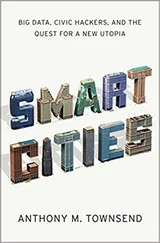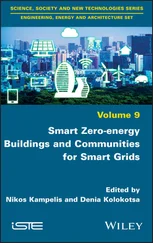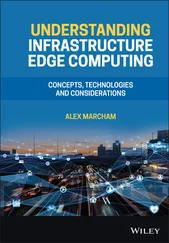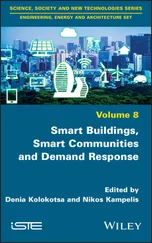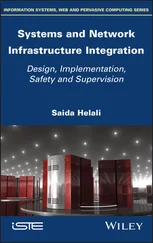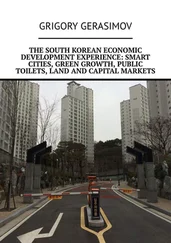Smart City Infrastructure
Здесь есть возможность читать онлайн «Smart City Infrastructure» — ознакомительный отрывок электронной книги совершенно бесплатно, а после прочтения отрывка купить полную версию. В некоторых случаях можно слушать аудио, скачать через торрент в формате fb2 и присутствует краткое содержание. Жанр: unrecognised, на английском языке. Описание произведения, (предисловие) а так же отзывы посетителей доступны на портале библиотеки ЛибКат.
- Название:Smart City Infrastructure
- Автор:
- Жанр:
- Год:неизвестен
- ISBN:нет данных
- Рейтинг книги:4 / 5. Голосов: 1
-
Избранное:Добавить в избранное
- Отзывы:
-
Ваша оценка:
- 80
- 1
- 2
- 3
- 4
- 5
Smart City Infrastructure: краткое содержание, описание и аннотация
Предлагаем к чтению аннотацию, описание, краткое содержание или предисловие (зависит от того, что написал сам автор книги «Smart City Infrastructure»). Если вы не нашли необходимую информацию о книге — напишите в комментариях, мы постараемся отыскать её.
The wide range of topics presented in this book have been chosen to provide the reader with a better understanding of smart cities integrated with AI and blockchain and related security issues.
Audience
Smart City Infrastructure — читать онлайн ознакомительный отрывок
Ниже представлен текст книги, разбитый по страницам. Система сохранения места последней прочитанной страницы, позволяет с удобством читать онлайн бесплатно книгу «Smart City Infrastructure», без необходимости каждый раз заново искать на чём Вы остановились. Поставьте закладку, и сможете в любой момент перейти на страницу, на которой закончили чтение.
Интервал:
Закладка:
1.4.10 SCP Design
SCP is technically reliable Byzantine consensus practice for blockchain and its respective contracts with a contract or blocks in terms of epochs, here, every epoch makes a target then decision based on available rules. The principle idea of SCP efficiently utilizes the existing computational power. It separates existed computational powers into sub-groups, where every group works on an existing algorithm to agree on a solitary result. In SCP designed algorithm, the processor completes five phases in every epoch; in the first step, with the help of the local computation virtual committee identifies a processor. In the second step, processors try to recognize remained processors implicated; in the third step, processors execute on an authenticated procedure to consent on a value. In the fourth step, final consensus algorithm validation and ending value from each spread. In the fifth step, distribute random generation for virtually independent random assessment.
1.5 Internet of Things and Blockchain
1.5.1 Internet of Things
The invention of the IoT impacts promotes our daily life than ever before. In the coming years, kitchen applications, utility materials, thermostats, televisions, cars, smart phones, intra-body sensors, and approximately everything connects with the internet then reachable from anytime, anywhere on the globe. The rising ease that IoT brought to the 19th century is unmatchable and uncomparable. Moreover, it continuously improvising every human segment, manufacturing starts from healthcare, smart home, e-healthcare, along with smart city to surveillance, data mining, intelligent transport, and manufacturing [6–8]. Scientists and researchers highly focused on addressing IoTs computation and communication scalability concerns from the past few years. Undoubtedly these two concerns are most important for the success of IoTs and should carefully explore. Both IoT safety and confidentiality are vital research actions to be conquered [10–16].
Up-to-date IoT systems are implemented with a central-based architecture and client-server-based access model. IoT dealings like data, documents, and instructions among IoT entities assigned to monumental, federal service providers. However, eventually, IoT is vulnerable to various privacy as well as security problems. In particular, federal and centralized service providers use IoT data intelligently; some of the centralized data gathering systems can rendering the method of hacking by malevolent activities, with awful consequences for citizens [18–28]. One more dispute is the authentication of IoT units, which is mostly employed naturally with limited supervision. If these issues not appropriately answered, there was a chance to create hard active and passive attacks.
The amalgamation of blockchain along with IoT has disruptive potential and assists the IoT’s development into our culture through providing subsequent essential rewards:
1 i. Anonymity: An IoT entity with the inclusion of blockchain with various secure keys, but it does not expose entities real characteristics and individuality.
2 ii. Decentralization: Long-established centralized methods need each operation must be legalized from end to end with a centralized model, which unavoidably transforms into a performance block. In opposition, third-party confirmation is not required in the blockchain because consensus processes preserve data reliability.
3 iii. Non-repudiation: It guarantees that the dealings can be authorized then illogical dealings not confessed—it is almost intolerable to remove any transactions once integrated into the blockchain.
While the blockchain might appear as per a solution to the IoT’s safety as well as privacy problems, but still numerous researches detect various challenges while employing IoT into the real-world. Greatest part of the research works states blockchain as an undeniable, incontestable data composition from literature. Still, it is theoretically unfocused to describe it as indisputable or not able to be forfeited. If truth be told, then there are patterns where the blockchain entries have been altering after attacks or misconduct of the system/network. As mentioned in the introduction section, blockchain technology has been broadly employed in various services like digital forensics, online micro-payments and insurance payments, supply chain management, and health-management documentation sharing [6–16]. By enlarging the blockchain skill to the IoTs, we can get a certifiable and distinguishable IoT system. Promising research studies in IoT appliances take advantage of blockchain skill to testimony transaction data, optimize existing method performance, and assemble next-generation structures, moreover, giving additional safety, regular transaction supervision, decentralized proposals, offline-to-online data confirmation, and many more.
IoT networks allocate direct communications as well as interaction among devices over the internet. At the end of 2025, the number of IoT (smart mobiles, vehicles, smart city, home applications, and various indoor and outdoor sensors) devices will reach above 25 billion. With numerous devices, conventional IoT appliances face contests in several points like information security, confidentiality, and healthiness. Blockchain affords a handy, well-located explanation to deal with many limits of conventional IoT appliances. Here, blockchain guarantees IoT data integrity, not including any third-party, and saves bandwidth and computational supremacy of IoT objects. Furthermore, blockchain can endow with a safe and sound outline aimed at IoT setup to send sensitive raw data without any centralized server [12–18].
1.5.2 IoT Blockchain
IoT with blockchain inclusion systems personalized and optimized to allocate IoT appliances. As we discussed earlier sections, IoT is employed in various real-time applications, but most of them prone to various attacks and issues. To moderate these tricky things, blockchain can be utilized to offer superior security along with reliability for time-honored IoT functions. Furthermore, the inclusion of blockchain into IoT is not an easy task because limitations of IoT devices, some of them are power consumption, task scheduling, and computational capabilities. To handle these concerns, many stabs to assume blockchain in IoT appliance [2–8].
Blockchain assumes various IoT appliances; however, there is a particular focus on digital payments, data storage, and smart contracts. Digital payment is the utmost applicable domain for blockchain. Although it primarily works on a scattered system maintained in high-performance machineries, superior optimization is now maintained by significant blockchains like Bitcoin and Ethereum, which are applied for objects/ things with inconsequential computation energy like smart phones, tabs, and pocket PCs.
1.5.3 Up-to-Date Tendency in IoT Blockchain Progress
Recent developments in various technologies boost the progression of IoT and blockchain and its continuous revolution. The recent trend is principally revealed in four characteristics: popularity, range of applications, development of underlying technology, and business models [4–14].
1 i. Popularity: From the last few years, the incorporation of IoT with blockchain appliances proliferating. In the early days, IoT applied to specific domains like industrial manufacturing and transportations. However, as time passes, many emergent businesses converted to the movement of IoT like digitalization, smart home, E-healthcare, and then smart city. Dissimilar brands of consensus processes offered, and then, basic upgrading has planned for IoT blockchains.
2 ii. Range of Applications: From the invention, blockchain was continuously employed in various domains; at the start, blockchain applied for decentralized currency structures. Bitcoin was foremost considered to make a decentralized currency scheme exclusive of any administration. With the expansion of blockchain expertise, smart contracts in Ethereum have facilitated a more comprehensive range of appliances other than economic use. The merger of IoT into blockchain schemes affords extra capacities for appliances. Logistics businesses spotlight employing blockchain to execute product tracking: Computer hardware and power-driven manufactured goods trades exploit blockchain to improve the interface among humans with IoT devices. Power industries exploit blockchain to execute power distribution then power transaction dealings.
Читать дальшеИнтервал:
Закладка:
Похожие книги на «Smart City Infrastructure»
Представляем Вашему вниманию похожие книги на «Smart City Infrastructure» списком для выбора. Мы отобрали схожую по названию и смыслу литературу в надежде предоставить читателям больше вариантов отыскать новые, интересные, ещё непрочитанные произведения.
Обсуждение, отзывы о книге «Smart City Infrastructure» и просто собственные мнения читателей. Оставьте ваши комментарии, напишите, что Вы думаете о произведении, его смысле или главных героях. Укажите что конкретно понравилось, а что нет, и почему Вы так считаете.

